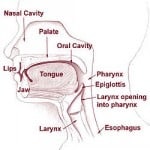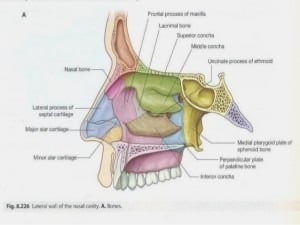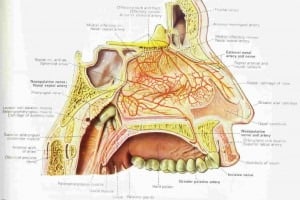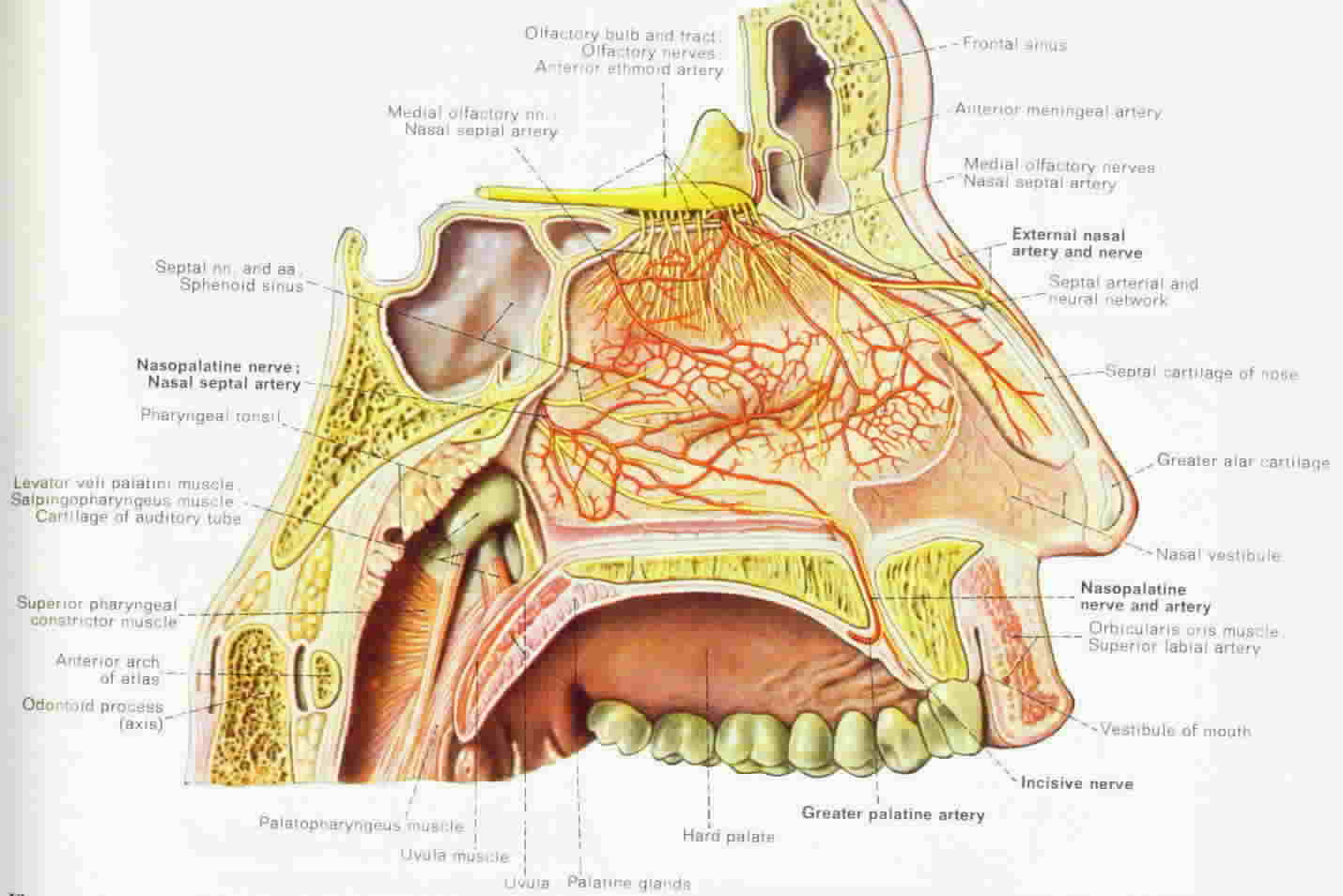Why is Nose Breathing Important?
Nose breathing is the most essential part of yoga. It is also poorly understood in modern culture. Breathing through the nose is  physiologically much different than breathing through the mouth; there is far more space in your nasal cavity than in your mouth to start. There is also a filtration system in the nose that doesn’t exist in the throat. You can see this on the right; the tongue takes up the vast majority of the space in the mouth and the nasal passageway is very small at certain points. The mouth actually makes for a more narrow and less effective breathing passageway, especially when you consider the benefits of the pressure system that exists in the nasal cavity. Your body craves breathing through the nose, especially while you sleep! Human breaths are more powerful through the nose.
physiologically much different than breathing through the mouth; there is far more space in your nasal cavity than in your mouth to start. There is also a filtration system in the nose that doesn’t exist in the throat. You can see this on the right; the tongue takes up the vast majority of the space in the mouth and the nasal passageway is very small at certain points. The mouth actually makes for a more narrow and less effective breathing passageway, especially when you consider the benefits of the pressure system that exists in the nasal cavity. Your body craves breathing through the nose, especially while you sleep! Human breaths are more powerful through the nose.
There are studies that have shown all kinds of benefits of breathing through the nose; it is even considered the proper method for breathing by the scientific community. “[Nose breathing] increases circulation, blood oxygen and carbon dioxide levels, slows the breathing rate and improves overall lung volumes ” Swift, Campbell, McKown 1988 Oronasal obstruction, lung volumes, and arterial oxygenation.
Breathing through the nostrils has also been proven to improve brain function; opposite nostril breathing stimulates the opposite hemisphere of cortex and the nervous passageways in the cortex (ie left nostril  breathing is associated with stimulating right brain activity).
breathing is associated with stimulating right brain activity).
There is also significant research being done on the relationship between the prefrontal cortex and the passageways to the lungs. It is being shown that there are major correlations between ADHD and sleep disorders and breathing habitually through the mouth. Information beyond the clinical applications for sleep apnea where hard to find; obviously the health need ($$) for assistance with sleep apnea is somewhat sizable, therefore there is more research done around it. However, it has been proven that alternate nostril breathing affects the brain’s physiology; there are some extremely close relationships between specific portions of the brain and the respiratory pathways, especially in the hindbrain (medulla and pons).
There is an ever-increasing body of research on the relationship between sleep apnea, asthma, and on the negative effects of breathing habitually through the mouth. Nose breathing is more protective and efficient at fueling the human body’s need for oxygen; however, the passageway is relatively easily obstructed. The mouth has been shown to be more efficient at releasing carbon dioxide quickly than the nose, although exhaling through the nose has notable benefits for the mucus membrane and cilia of the nose. Let’s explore how the nose is a powerful filtration system for the lungs.
Filtration Systems
When I was 25 I visited Beijing with some of my friends from the time that I studied abroad in Paris. While I was there, I noticed myself continually nose breathing due to the large particles in the air. I was fairly deep into my yoga practice so I was used to breathing through my nose for long periods of time, but I instinctively understood that breathing through my nose would help to filter the air and keep the large bronchitis and cancer causing particles out of my trachea and mouth.
“The nose serves as the only means of bringing warm humidified air into the lungs. It is the primary organ  for filtering out particles in inspired air, and it also serves to provide first-line immunological defense by bringing inspired air in contact with mucous-coated membranes that contain immunoglobulin A (IgA).”
for filtering out particles in inspired air, and it also serves to provide first-line immunological defense by bringing inspired air in contact with mucous-coated membranes that contain immunoglobulin A (IgA).”
The nose assists in stimulating the immune system. The changes in pressure stimulate the physiological processes associated with the maintenance of the mucus membrane and help to retain oxygen in the lungs. It also provides humidity and heat for the air entering the lungs, as well as increased filtration from the cilia and small hairs that line the nose. In the picture above, you can see the olfactory(smell) nerves and the organization of blood vessels within the nasal cavity. Overall, it is a good idea to concentrate on breathing through the nose, whether sleeping, awake, or even during milder forms of exercise.
Why is this important for yoga?
This information helps to explain a large portion of why yoga is so beneficial for the body. Breathing intensively through the nose for one to two hours creates space for the habit of constantly breathing through the nose. This is probably the biggest reason that in clinical studies, sleep quality of subjects who practice yoga is higher. Breathing’s relationship to the functioning of the brain is also interesting; some studies have shown that yawning helps to cool the brain, but the act of yawning is probably far more complex than that simple generalization.
Questions?
How does nasal breathing affect the hippocampus and memory?
How does nose breathing affect the hypothalamus and the regulation of your emotions through the endocrine system?
What parts of the brain does yawning cool?
What portions of the cortex received the greatest benefit from breathing through the nose? How about the mouth?
These questions, at least as far as I can tell, science has yet to answer. But we do have clinical evidence that yoga positively affects mood disorders, PTSD, anxiety, depression, and there are a lot of very positive findings between yoga and cardiovascular health, while simply nasal breathing is proven to positively affect the heart and lung tissue. It is probably just a matter of time before we discover more of the benefits of yoga and of nose breathing.
Don’t be a mouth breather! 🙂
References:
- http://emedicine.medscape.com/article/874771-overview
- http://onlinelibrary.wiley.com/store/10.1111/j.1398-9995.1999.tb04402.x/asset/j.1398-9995.1999.tb04402.x.pdf;jsessionid=AECDFA5F44190494D5E7B315E7A6FEB2.f01t03?v=1&t=ilmeorkg&s=c4bc17315db2cd2d969feca8ad933515fa409e02&systemMessage=Wiley+Online+Library+will+be+unavailable+for+up+to+3+hours+on+Saturday+19th+March+2016+from++11%3A00-14%3A00+GMT+%2F+07%3A00-10%3A00+EDT+%2F+19%3A00-22%3A00+SGT+for+essential+maintenance.++Apologies+for+the+inconvenience.
- http://care.american-rhinologic.org/nasal_physiology
- http://medind.nic.in/iad/t05/i4/iadt05i4p251.pdf
- http://www.ncbi.nlm.nih.gov/pubmed/8063359
- http://journals.lww.com/neuroreport/toc/2013/12040
- http://online.liebertpub.com/doi/abs/10.1089/acm.2005.11.711

